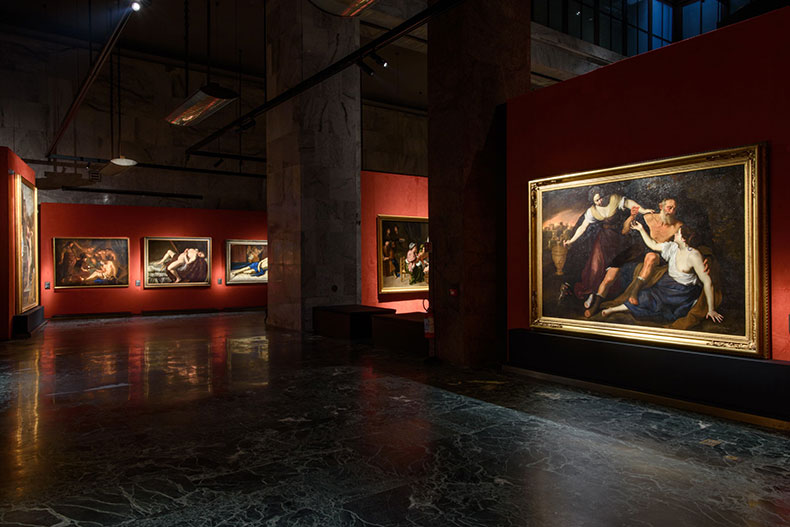Those who find themselves missing Artemisia Gentileschi’s Self Portrait as Saint Catherine of Alexandria (1615–17) from the National Gallery in London in the grey days of January would be well served to follow its example by wintering in sunnier climes. The self-portrait is one of 25 works by the artist that make up the exhibition ‘Artemisia Gentileschi a Napoli’ at the Gallerie d’Italia, an expansion of the National Gallery’s presentation in 2020. Presented to spectacular effect in the sala grande of Marcello Piacentini’s Palazzo del Banco di Napoli, built in 1940, the show is an impressive example of what architecture and painting can do together.
It is a reality that one of the finest spaces to see art in the city of Naples is now a bank. In recent years, Intesa Sanpaolo has launched an ambitious cultural project, retrofitting major Italian landmarks in Milan, Naples and Turin to house its 35,000-work collection. In Naples, their seat is Piacentini’s late-Rationalist masterpiece, re-opened in May 2022 with 10,000 square meters of exhibition space designed by Michele de Lucchi of Memphis fame. Clients of the bank can, at least, forgo the €7 admission fee.

Self Portrait as Saint Catherine of Alexandria (c. 1615–17), Artemisia Gentileschi. © The National Gallery, London
Artemisia Gentileschi (1593–1653) has long been most closely associated with Rome, where she trained in her father’s studio, and where the best-known events of her life – her sexual assault and prosecution of a legal case against her attacker – took place. But she spent more than two decades in Naples, from 1630 to 1654, with a brief two-year sojourn in London between 1638 and 1640. This period was the height of Artemisia’s fame, in which she was working on commission for the most powerful courts of Europe, from Madrid to Vienna to London.
The show indulges in the now-obligatory biographical detail, but does not dwell on it, moving briskly to works by the (largely but not exclusively male) artists alongside whom Gentileschi lived and worked in Naples. Among the greatest delights are two canvases by Paolo Domenico Finoglia, whose Annunciation (1630–35) gives us a Virgin and messenger of pure, coiled potential, clad in obsessively rendered drapery. Another highlight is the never-before-exhibited Rape of Europa by Annella de Rosa, one of the few Neapolitan female artists. There are paintings by Onofrio Palumbo and Bernardo Cavallino, Gentileschi’s studio collaborators; to see their works alongside hers is to recover something of their painted conversations.

Samson and Delilah (1638), Artemisia Gentileschi. Intesa Sanpaolo Collection; © Claudio Giusti
In Artemisia’s paintings, life unfolds in the shadows, from the shady balustrades of Susanna and the Elders (1610) to the half-lit palate of a Self Portrait from the 1630s, glowing with embers of muted pigment. Unlike Caravaggio, for whom darkness is something to be pierced by miraculous rays of light, she is a master of the murky recesses (there are, wisely, no Caravaggios included in the show, but it would be a wasted visit not to duck upstairs afterwards to see his last, wrenching Martyrdom of St. Ursula from 1610). It is this sensibility that is mirrored to dramatic effect in the design of the exhibition. Piacentini’s massive central skylight and internal clerestory windows have been blacked out, plunging the hall into darkness. The large-scale paintings hang in isolated pools of light while the smaller works have been placed inside specially-built hutches which enclose the viewer and draw out the ways in which Artemisia intertwines intimacy with violence. The experience echoes the proximity and darkness necessary for Judith to carry out her gruesome mission, or the silence with which Delilah eyes up the sleeping Samson’s dark locks.
Seicento Italian painting meets its match in Piacentini’s green Issogne floors and red, razor-straight pilasters – oiled canvas and polished marble reflecting in one another’s depths. The architect’s exaggerated classicism is mobilised to monumental effect in these rooms. Soaring piers connect the waist-high grey blocks of the bank’s counters, left in place, to the hulking stone joists above. The materials used throughout speak of histories of power and violence, especially on the building’s second level, where a formal meeting room is clad in black and white marble that was extracted from Ethiopia after Italy’s invasion in 1935. Power and its imposition on the bodies of others is, of course, Artemisia’s great subject. Within this setting, her scenes of blood, greed and retribution also become reminders of the human costs of imperialism.

Installation view of ‘Artemisia Gentileschi a Napoli’ at Gallerie d’Italia. Courtesy Gallerie d’Italia
While the curators refer to Gentileschi’s feminist afterlife in the wall texts and catalogue, they treat her biography with more delicacy than other recent exhibitions. In focusing on the end of her life, they show us a painter whose career persisted well beyond the trials of her Roman years to take in new influences and experiences from marriage and motherhood to life at court. A programme of archival research associated with the show has yielded fascinating new documentation of Artemisia’s time in Naples, including the address in the seaside neighbourhood of Chiaia where she was living when she died of the plague in 1654. And yet to sit in the recesses of this former banking hall, surrounded by Artemisia’s scenes of lush menace and sensual transcendence, is to yield to the artist’s power and become lost in the drama of the work.
‘Artemisia Gentileschi a Napoli’ is at Gallerie d’Italia, Naples, until 19 March 2023.














![Masterpiece [Re]discovery 2022. Photo: Ben Fisher Photography, courtesy of Masterpiece London](http://zephr.apollo-magazine.com/wp-content/uploads/2022/07/MPL2022_4263.jpg)
‘Like landscape, his objects seem to breathe’: Gordon Baldwin (1932–2025)